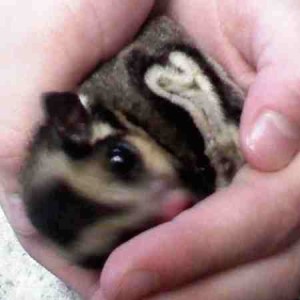Bonding with your Sugar Glider can be easy or can be made to be difficult. In this section I am going to assume that you bought a nice, 7-12 week old, hand raised baby Sugar Glider. The reason I make that assumption is because that is the only animal you should settle for. It is also the exact type of animals that Tropical Attitude Pets strives to provide each and every one of our customer’s. I will briefly discuss older or more scared babies at the end of this section.
There are breeders and websites that recommend that when you get your new baby, that you not hold it for at least 3 days. Just let it get used to its new cage and new home. You could not get worse advice if you tried.
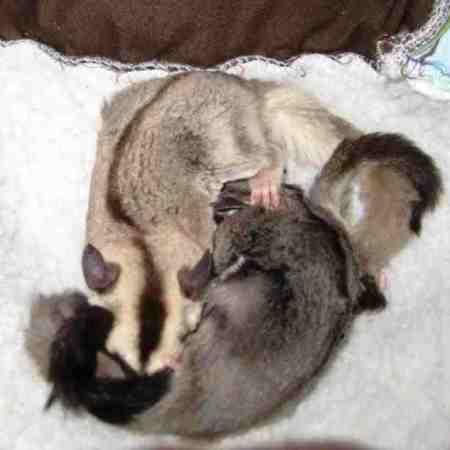 Sugar Gliders are very social animals and adapt quite readily to the new owner if handled properly. The first thing to know is that you cannot handle the new baby too much as long as it still gets to eat and sleep. A new baby that is held a lot for the first few days will almost always feel safer with the new owner in as little as 24-72 hours. This means that it is not uncommon for a new glider to cling to the new owner rather than jump off of the owner in very short order.
Sugar Gliders are very social animals and adapt quite readily to the new owner if handled properly. The first thing to know is that you cannot handle the new baby too much as long as it still gets to eat and sleep. A new baby that is held a lot for the first few days will almost always feel safer with the new owner in as little as 24-72 hours. This means that it is not uncommon for a new glider to cling to the new owner rather than jump off of the owner in very short order.
The second thing you need to know is that carrying them in a secure bonding pouch or in a shirt pocket with a flap is almost as good as having them in your hands. However, use the pouch and pocket as an adjunct to holding them. If you always carry them in the pouch or pocket and hold them rarely in your hands, they never get to totally trust your hands. So at first, until they are showing signs of trusting you, err on the side of holding them rather than on the side of carrying them in a pocket.
Thirdly, you need to know that when holding them in your hands, hold them tight as described in the preceding section called Picking a Sugar Glider. The more they trust you, the less you will have to hold them tightly to get them to feel safe. As the bonding progresses, you will find that you are able to hold them more loosely.
Bonding takes place firstly by the glider getting to know your scent. He will remember that scent as a safe person to be with. So it will get easier and easier to pick it up out of the cage, or wake it up to get in your hand while sleeping in its pouch, etc. However, as the glider gets used to you, he is also learning your voice, your sight, and his name, and even your heartbeat if you carry him in a pouch or pocket on your chest.
The Sugar Glider is going to have one person in the family that is known as its “primary bond”. That will almost always be the one who carries it around the most. Sugar Gliders are often considered a one person pet. However, they are really colony animals and will learn to love each and everyone in your family that treat it well and holds it properly, including your pets.
It will however have a primary bond, much like a dog has one person it is the most bonded to, but still loves and protects the entire family. So, while bonding to your new baby, do not be afraid to allow the other members of the family to hold the glider as well, so that it becomes socialized with all members of the family. Also let your pets have access to the cage so that the glider and they can work out all of their fears and aggressions towards one another. See more about this in the section entitled Sugar Gliders and Other Pets. If you hoard your pet and never let it have social life with others, it will be bonded to you, but will always be afraid of other people. Most of us don’t want our glider to be that way.
The bonding process normally takes about 2 weeks. Generally the more you hold them early on, the faster the bonding proceeds. It is not at all uncommon at one of my shows where I sell the gliders to have a baby in my outer shirt pocket, and have it start feeling so safe with the crowd that I can let it be in their hands, and when they hand it back to me, have it crawl from my shirt sleeve right up my chest and find the pocket and go headfirst into the pocket. Sometimes this happens with a 7-8 week old baby after just 3-5 hours of being in my pocket, and having several good experiences with the customers.
Here is a key element to the bonding process. Do not let your glider have any freedom for the first two weeks. I tell all of my customers that I don’t want their new baby to even touch its foot on the couch or any object for the first two weeks. If you hold them and carry them with you and put them back in the cage whenever you can’t have them with you, you will have taught them something very important. You have taught them that you are the only safe thing outside of the cage. By then they are bonded to you and they feel that the cage and you are the only two safe places to be. You have become the “center of the universe” for your glider, and you represent total safety to him.
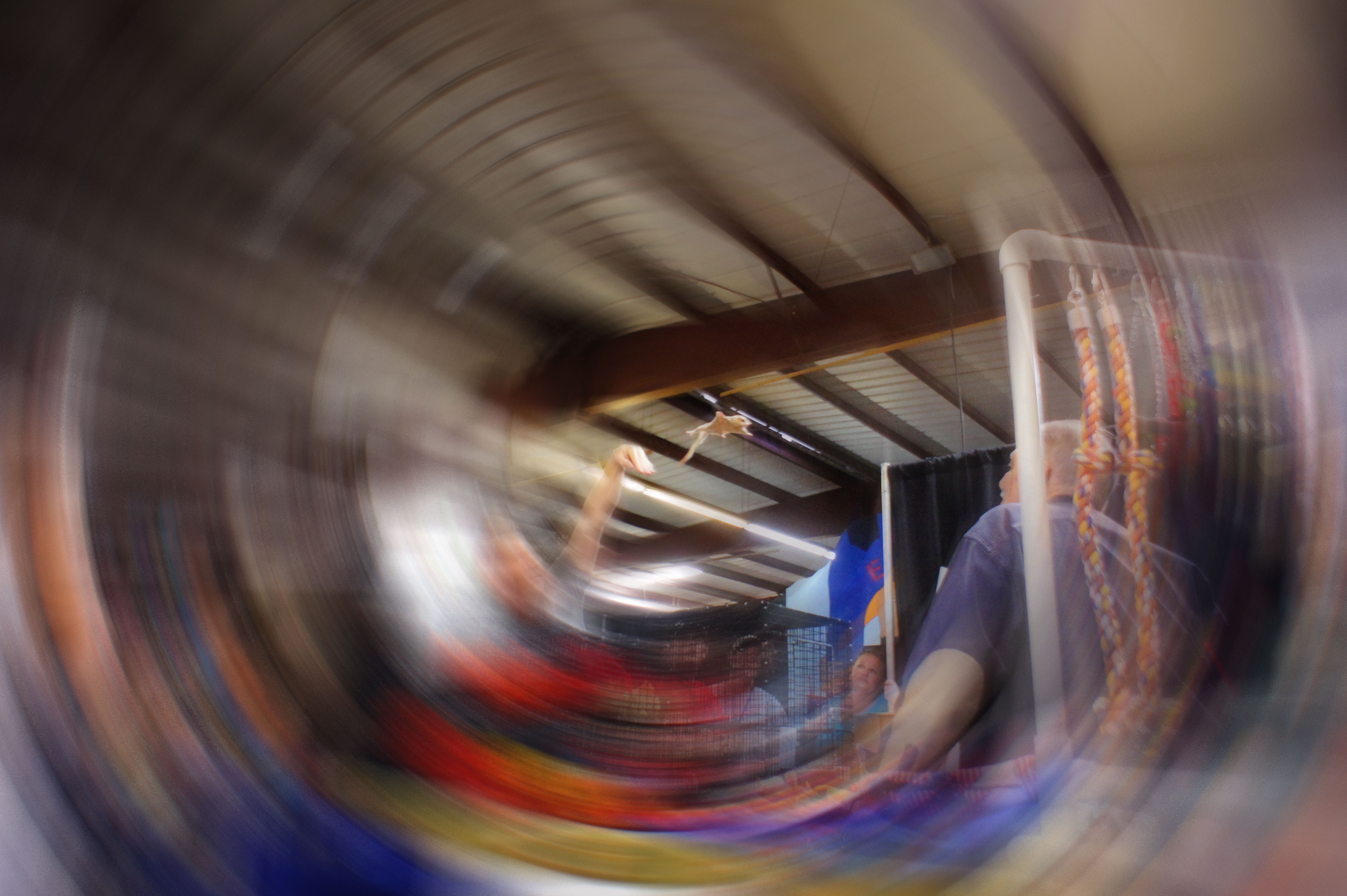
It is time to find a friend or neighbor who has not held your glider yet, and put him on the back of that person’s hand. Have the stranger (to the glider) hold him up about eye level to you, and just 12-18 inches from you. Call your glider by name and he should want to jump to get back to safety.
Because you have given your glider no freedom, he doesn’t know that he can glide yet. Once he is deeply bonded (usually about 2 weeks if you have done your part) it is time to teach the glider to glide. Since you represent safety, he now has a reason to glide and a target. He will want to get back to safety. It is time to find a friend or neighbor who has not held your glider yet, and put him on the back of that person’s hand. Have the stranger (to the glider) hold him up about eye level to you, and just 12-18 inches from you. Call your glider by name and he should want to jump to get back to safety. Normally he will jump to your chest or shoulder, and dive back into the pocket, pouch, cleavage, or wherever you carry your glider. Over the next few days you can gradually teach the glider that he can jump from higher and further distances and soon he is actually gliding to you from respectable heights.
At this point your glider is bonded to you and is jumping to you. He thinks the only two safe places are his cage and with you. After a few months of no freedom, if you want to expand your fun with your glider, you can now re-teach your glider that there is one place that he can play away from your body. If you want to be able to let your glider have some fun and get some exercise each evening for about an hour, pick out one single room of the house (one that is closed off to just that one room), and teach it that this space is safe. In my case it is my home office. I let my gliders learn that when I am in that one room they are safe to play. The way to do it is simple. As you sit down to your computer for instance, take your glider out of your pocket and set him on the desk to explore. He may look around for a bit and climb back in your pocket. It will take him several days if not a week or two to gradually explore more and more until he knows the room and feels safe being away from you for 5-10 minutes at a time. Once he does feel safe in that room however, you will have a great time watching his antics, and playing with them. Mine will go to my ficus tree first. Then in about 10 minutes they are on my shoulder just checking in with the center of the universe. Then off they go to the gun rack, or the bookshelf, or the curtain rod, etc. About every 5-10 minutes they check in to make sure all is right. If I get up they will run up my leg or glide down to me so that I don’t leave them behind. Usually in about an hour mine will be back in my pocket for a rest and I put them up for the night.
Even with my very well-mannered Sugar Gliders (Blanco and Ann Bolin, and Buddy and Belle) they will not always come to me upon command when they are having fun. So you may have to go pick them up if you want to put them up before they are ready.
Now your glider has three places he feels safe. They are its cage, you, and the one play room. However, the rest of the world is unknown territory. They do not want to jump into unknown territory if properly bonded. These results won’t occur if you don’t first make them feel that your hands are safety, or if you give them freedom too early on, or if you teach them to glide too early to other objects like from your hand to their cage, etc.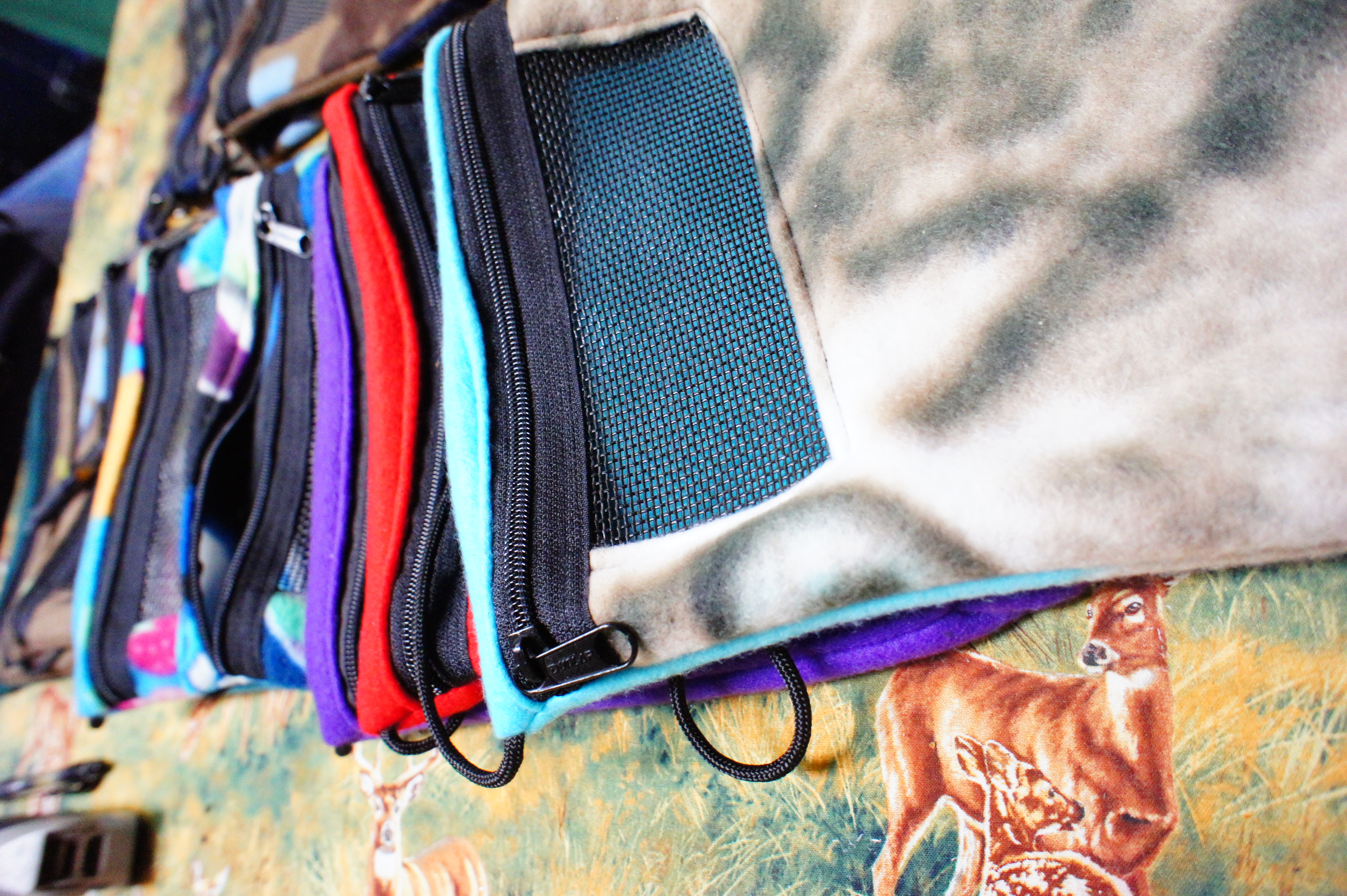
Now I want to discuss a few problems people tend to have with their first Sugar Glider. Remember the first one is the most difficult because you don’t know what you are doing yet. By the time you have done it once, it is much easier the second time around because you are experienced and know what the glider wants and are not afraid you are going to make a big mistake.
Crabbing is what we call the sound they make when they are scared. It is the loudest noise they make and it goes completely away if you get your glider well bonded to you. Some people really like this sound, so enjoy it while you can because it will not persist as you get it more bonded to you. This noise means that it is scared, not mean. It can be a precursor to biting if it is really very scared, but normally just means that it is scared and needs to be held properly. The fastest way to get through this is holding them more tightly. Most people hold them far too loosely for them to feel like they did in Mom’s pouch. Reread my section on Picking a Sugar Glider and HOLD THEM TIGHTER AND GIVE THEM ISOLATION!!
Biting is not normally a problem from 7-12 week old, hand raised babies. As previously discussed in a previous link, this is the only age gliders you want to buy as pets. If you get the right age gliders but they are not hand raised, then you will normally go through a biting stage. With hand raised babies of this age however, you normally will not have any biting at all. However, if you don’t provide the safety and security they need while bonding, they can get scared enough to bite. Normally it will be a firm pinch that may hurt a little, but normally won’t break the skin. Remember your baby will only bite if it feels insecure, so hold it tight, and do not be afraid of your glider. If you are afraid, the glider picks up on it immediately and it causes it to be afraid. So take a deep breath, be calm, and be very resolute in your actions. Very resolutely and deliberately pick up your glider, position it in your hand like a little ball, and squeeze it to give it security. Most biting problems with a hand raised baby will disappear in a day or two of proper holding.
Another area of difficulty for new owners is waking them up and taking them out of a pouch and their cage.
When taking your new glider out of the pouch, put the animal in your fist while it is in the pouch. By this I mean that the glider is in the pouch and your fist is on the outside of the pouch. Make it into a little ball and let it relax by recognizing your scent. Then open the pouch, put your other hand in the pouch, and transfer the baby from one fist to the other, bringing the baby out in the second tight fist. There normally is no fear on the baby’s part when this is done right. This will only be necessary until the baby is getting bonded well with you, and has no fear of your hand coming at it.
The cage offers a different challenge. Your glider feels safe in his cage. He has a nice tee shirt piled on his heat rock and it is very warm and secluded and comfortable. Then all of a sudden the cage shakes and in comes a hand to wake him up and pick him up. Until the glider has no fear of your hand, he will normally try to evade you. He will no doubt be crabbing and he may even stand up on his hind feet with his front feet in the air and lunge at you to try to scare you away. What should you do? Wait for another time to pick it up? Definitely not! Instead of grabbing at it when it is evading you, just put your hand in the cage and herd the glider to a side or floor or shelf where you can quickly and cleanly cover the glider with your hand. Just press him to the wire and hold him down for a few seconds until he recognizes your hand. Then do not lift your hand, but rather make a fist around the glider and gently pull his feet from the wire. If you lift your hand he will squirt right out of your finger tips and you will have to start over.
If the glider stands up and lunges or acts like he will lunge, do the same thing. Very resolutely put your hand over the top of him and press him against the wire, again picking him up as in the paragraph above. By doing this and not letting him learn that he can get his way, you will stop that behavior and he will not get spoiled thinking he can have his way by producing bad behavior.
To sum up:
- Start holding your babies as soon as you get them.
- When you can’t have them in your hands, use a pouch or pocket.
- Remember to hold them tightly whenever they are feeling scared.
- Share the glider with family members.
- Do not give the glider any freedom for at least two weeks.
- Once fully bonded, your glider is ready to learn to glide to you.
- After fully bonded, and gliding to you, you can teach them that one and only one room of the house is a safe place to play for an hour each evening.
- Do not be afraid of your glider, and do everything resolutely and deliberately.
Follow these tips and you should have a very happy and well bonded glider to carry with you wherever you want to go. Mine goes in my tee shirt pocket with me fishing, prospecting, boating, motorcycling, 4 wheeling, shopping, restaurants, etc., etc.
Now as promised at the start of this section I will address older or meaner (more scared) Sugar Gliders.
With rare exceptions I do not consider Sugar Gliders over about 12 weeks OOP to be pet quality. It is possible to bond with an older glider, but it is much harder, and usually doesn’t result in the deep bond a young one will develop. The principles are the same however, except that the time frame may be much longer, and there may be some hard biting to endure before the older glider feels safe and stops biting. Sometimes an older glider doesn’t want his head tucked in, but wants to see out. You will have to experiment to find out what makes the older glider feel safe.
Let me suggest that you never buy gliders off of the internet unless you really trust the seller, because you do not know what you will get. You should always buy from someone that can let you see and hold the prospective animal. One of the biggest reasons that there are so many rescue Sugar Gliders is because they were bought sight unseen and did not turn out to be as represented. We ship babies when necessary, and we send the best we have, but not all sellers do that. Many will send you their older ones that are soon to be not sellable. I have seen babies sent that were supposed to be 8 weeks and they were close to a year old. This is not a good purchase. That animal will never have a really deep bond to anyone. It may be a fun pet to care for and watch in the cage, but will not be able to go with you to the store in an open pocket. It is however, a noble thing to rescue a pair of older Sugar Gliders because they still need a good home. We rescue them all of the time, and either find them a good home, or they can be paired up and become breeder pairs and have a good home and a purpose. You can learn more about our rescue program in the About Us section called Our Rescue Efforts.

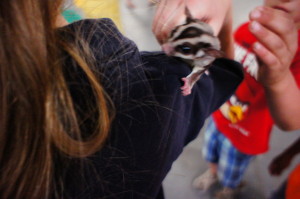
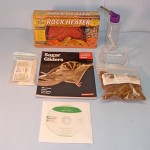
 One sign of dehydration is the loss of plumpness in its body. In fact it will feel like skin and bones in extreme cases. When you lift the skin of the glider on his back, and it shows no sign of springing back into place, it is dehydrated. Other signs are diarrhea, lack of cleaning itself, and of course lethargy.
One sign of dehydration is the loss of plumpness in its body. In fact it will feel like skin and bones in extreme cases. When you lift the skin of the glider on his back, and it shows no sign of springing back into place, it is dehydrated. Other signs are diarrhea, lack of cleaning itself, and of course lethargy.
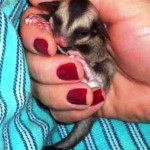 also a place of complete safety. Later in life, the safest place for a glider to be is in the den with its colony. Here they are out of harms way from predators. The whole colony will sleep piled upon one another. Again it is warm, snug, and moving, because as one glider wakes up and discovers it is on the top of the pile, it burrows under the others for warmth. When you hold your baby in your hands and give it lots of contact with your hands, massaging it firmly, but calmly and gently, you create the sense of security it felt in the pouch and in the colony. Again, it is warm, snug, and moving. We know of no quicker or better way to get the glider bonded to you than this method.
also a place of complete safety. Later in life, the safest place for a glider to be is in the den with its colony. Here they are out of harms way from predators. The whole colony will sleep piled upon one another. Again it is warm, snug, and moving, because as one glider wakes up and discovers it is on the top of the pile, it burrows under the others for warmth. When you hold your baby in your hands and give it lots of contact with your hands, massaging it firmly, but calmly and gently, you create the sense of security it felt in the pouch and in the colony. Again, it is warm, snug, and moving. We know of no quicker or better way to get the glider bonded to you than this method. My Sugar Glider has an eye problem.
My Sugar Glider has an eye problem.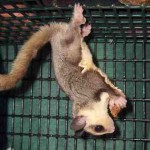
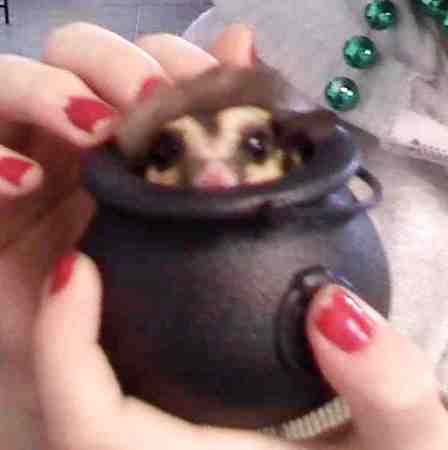
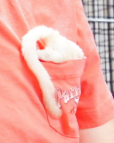
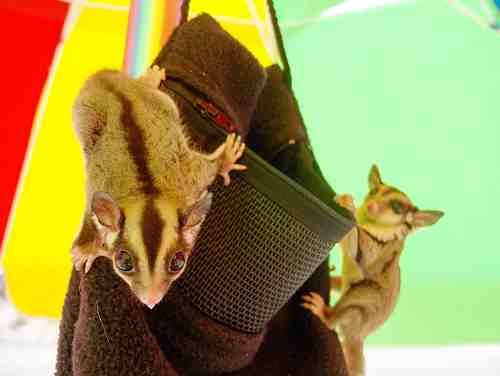
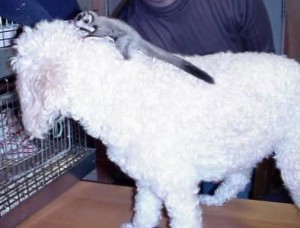 One of the biggest fears of new, or would-be owners of Sugar Gliders is the worry that their dog or cat or other pets will kill their baby Sugar Gliders. Of course this is a legitimate fear and should be considered in your decision. However, this is usually overblown by far.
One of the biggest fears of new, or would-be owners of Sugar Gliders is the worry that their dog or cat or other pets will kill their baby Sugar Gliders. Of course this is a legitimate fear and should be considered in your decision. However, this is usually overblown by far.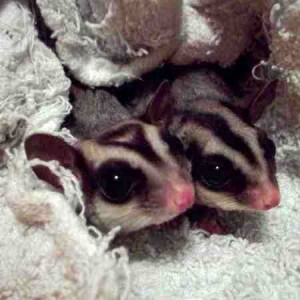 they feel just as happy to be with each other. The result is that they never feel depressed or lonely, and you have two very well adjusted, happy pets.
they feel just as happy to be with each other. The result is that they never feel depressed or lonely, and you have two very well adjusted, happy pets.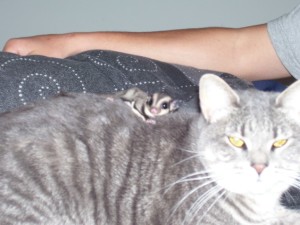 in the evening she opens the cage door and the glider comes out and plays with the cat. One will chase the other and then they reverse rolls and back and forth. She also described that after about an hour of this play, the cat gets tired and climbs into the open door of the glider cage, curls up and soon the glider comes in the cage and sleeps in the curl of the cat. This is an extremely bonded pair of animals, however it is not unique. One of my customers related this story to me. They have an Australian Shepherd dog. It is respectful of the glider and doesn’t hurt it, but is not especially playful with it. However, the Sugar Glider loves the dog and always wants to play. She said that it was common to see the glider following the dog around everywhere while the dog is trying to get some privacy.
in the evening she opens the cage door and the glider comes out and plays with the cat. One will chase the other and then they reverse rolls and back and forth. She also described that after about an hour of this play, the cat gets tired and climbs into the open door of the glider cage, curls up and soon the glider comes in the cage and sleeps in the curl of the cat. This is an extremely bonded pair of animals, however it is not unique. One of my customers related this story to me. They have an Australian Shepherd dog. It is respectful of the glider and doesn’t hurt it, but is not especially playful with it. However, the Sugar Glider loves the dog and always wants to play. She said that it was common to see the glider following the dog around everywhere while the dog is trying to get some privacy. going to be passing through her town within about 2 weeks. Since that call I have seen this trait of Rotties over and over. They seem to be about the very best dog with gliders.
going to be passing through her town within about 2 weeks. Since that call I have seen this trait of Rotties over and over. They seem to be about the very best dog with gliders.

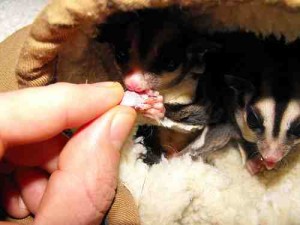

 Now finally, let’s look at the study.
Now finally, let’s look at the study.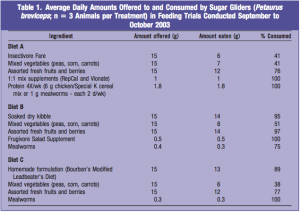 Many things were studied and discovered through their pre and post blood-work, but we will confine our observations to the most important and less esoteric findings.
Many things were studied and discovered through their pre and post blood-work, but we will confine our observations to the most important and less esoteric findings.

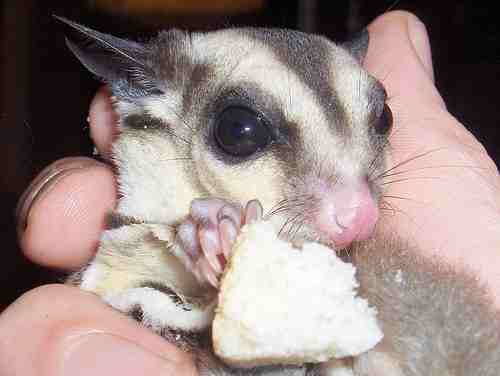
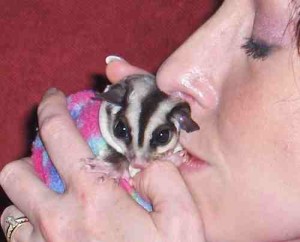 There are several things to consider while picking out your Sugar Glider. It is very important to take these considerations to heart so that you end up getting the best pet for your money. If you end up with the right Glider, you will absolutely love your new pet. You will also be glad that you took these steps in picking out your Sugar Glider because a little effort at this point will pay off for up to 15 years.
There are several things to consider while picking out your Sugar Glider. It is very important to take these considerations to heart so that you end up getting the best pet for your money. If you end up with the right Glider, you will absolutely love your new pet. You will also be glad that you took these steps in picking out your Sugar Glider because a little effort at this point will pay off for up to 15 years.